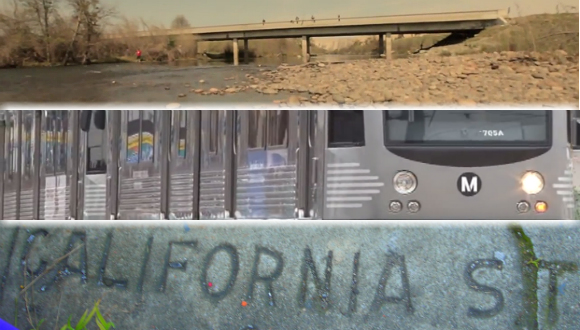
(Sidewalk Photo Credit: m./Flickr)
Long before water pipes began bursting in Los Angeles and dams started cracking in the Sierra foothills, the California Economic Summit has been exploring ways the state can make needed investments in California’s aging infrastructure.
With less than a month remaining in this year’s legislative session, the Summit sent a letter to the Governor and Legislative leaders this week urging lawmakers to move forward with one promising option—a proposal to create new local infrastructure development tools known as “Enhanced Infrastructure Financing Districts” (EIFDs).
Accompanying the letter is a How-to Guide created by the Summit detailing how local and regional agencies could use this new authority to invest in everything from sidewalk repair and water infrastructure (including, yes, next-generation water systems) to the implementation of sustainable communities plans.
“The Administration’s proposed EIFDs would give communities more authority to build the infrastructure California needs to achieve its growth and sustainability goals,” says Mark Pisano, a USC Price School of Public Policy senior fellow who coauthored the Summit report—and who was one of more than a dozen economic development experts signing on to the Summit letter.
“These financing districts would not only be able to build all public infrastructure, they could also serve as a platform for multiple funding streams—including private financing. The districts could also encourage the types of policy integration necessary to successfully implement regional sustainable communities strategies.”
The scope of the problem
With California’s economic outlook beginning to brighten, the Legislature has spent the last two years discussing a variety of proposals for increasing local infrastructure investment. By some estimates, the state will need to invest $765 billion in the next 10 years on everything from transportation and energy to water and school facilities, but the state and local governments only have the resources to pay for about half of this amount.
While the state lacks funding that would match the scope of the problem—and with no sign of increased federal support—the Summit’s Infrastructure action team has concluded that existing public resources must be complemented by a new working relationship among the public, private, and non-profit sectors.
“The new Enhanced Infrastructure Financing Districts,” says Pisano, “present a unique opportunity to begin this work.”
The Summit paper explains why, providing a step-by-step guide that shows how local and regional agencies can access the wide variety of new funding streams that will be available to EIFDs. The paper notes four areas, in particular, where EIFDs can improve local infrastructure development:
- Reduce vote requirements: Forming an EIFD would require 55 percent approval, instead of the current two-thirds. Once a district is established, it could use a range of financial tools without further voter approval. Only issuing tax increment bonds would require another vote—with a vote threshold of 55 percent.
- Expand financing authority: The new EIFDs would allow local leaders to support infrastructure projects through multiple funding streams, including a full complement of existing public mechanisms (tax increment authority, benefit assessments, and fees), as well as private investment and procurement.
- Increase investment in different types of infrastructure: The enhanced districts would be able to build every type of infrastructure: transportation, water, flood control and stormwater quality management, transportation, energy, public facilities, energy, and environmental mitigation—so long as a direct connection can be established between the needed infrastructure and its users. The paper also provides a case study of how this type of modeling has been conducted successfully by regional planners in Southern California.
- Allow more flexible institutional collaborations: The Administration’s proposal also would give communities more flexibility to accommodate regional growth by making infrastructure investments across jurisdictions through Joint Power Authorities.
The Summit letter makes the case that whether a public agency is interested in anything from upgrading sidewalks and streets for stormwater collection to expanding transit stations and building affordable housing, the new EIFDs will provide local governments with a far more robust investment mechanism than they currently have at their disposal.
“While existing, single-purpose funding makes it difficult to achieve all of these outcomes, they could be accomplished using the full range of tools provided by an EIFD,” says Pisano.
If structured correctly, in other words, these new districts could play an important role in driving sustainable growth by connecting a vast number of infrastructure projects with an array of new funding streams.
This will not only empower local leaders to address local infrastructure issues—it could also begin to provide California with a way to take on one of its preeminent fiscal challenges.

